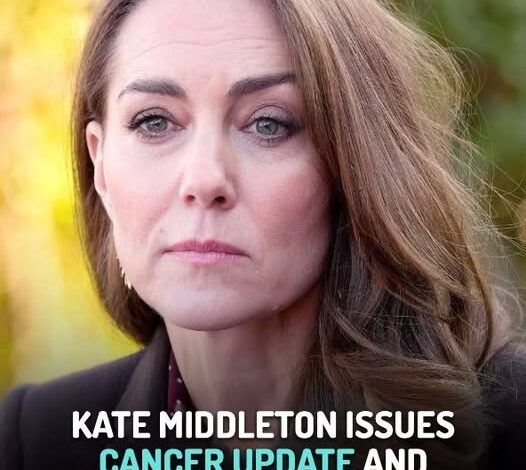
The Princess of Wales has opened up about one of the most personal and painful chapters of her life, candidly discussing the challenges of battling cancer and, even more poignantly, the struggles that followed treatment. In a rare and deeply emotional revelation, Princess Catherine described life after chemotherapy as “really, really difficult,” shining a light on a stage of cancer recovery that is often overlooked and rarely spoken about in public.
The Shocking Diagnosis
In March 2024, Catherine broke her silence and publicly announced her cancer diagnosis, putting an end to weeks of speculation about her absence from royal duties. The disclosure came after relentless social media rumors and media scrutiny, illustrating the extraordinary pressure and visibility that comes with her position in the Royal Family.
What began as what doctors expected to be a routine abdominal procedure in January 2024 quickly escalated into something far more serious. “At the time, it was thought that my condition was non-cancerous. The surgery was successful,” she explained in her announcement. “However, tests after the operation found cancer had been present.”
The diagnosis was a life-altering moment that set the princess on an unexpected path of aggressive treatment. Her medical team immediately recommended preventative chemotherapy to ensure the best chance of recovery.
Balancing Parenthood and Illness
Among the most difficult aspects of the diagnosis was how to communicate the news to her young children—Prince George, Princess Charlotte, and Prince Louis. Catherine admitted that it took time and careful thought to explain the situation in a way her children could understand without instilling unnecessary fear.
“It has taken us time to explain everything to George, Charlotte, and Louis in a way that is appropriate for them, and to reassure them that I am going to be okay,” she said. The statement underscored the added weight parents carry in such circumstances: not only fighting for their own lives, but protecting their children’s sense of stability and security.
Stepping Away from Public Life
Throughout her treatment, Catherine stepped back almost completely from royal engagements and public appearances. The demands of chemotherapy required her full focus on health and healing, which meant pausing her extensive charitable commitments and reducing her public presence to almost nothing.
By September 2024, she was able to share uplifting news: she had completed her chemotherapy regimen. That milestone was followed by another in January 2025, when she announced she was officially in remission—a moment of relief and joy for her family, supporters, and millions who look up to her resilience.
The Overlooked Challenges of Post-Treatment
While remission marked the end of one phase of her journey, Catherine made it clear that the hardest part was not necessarily over. During a visit to a hospital garden in Essex, she spoke candidly about the unexpected struggles of post-treatment life.
“You put on a sort of brave face, stoicism through treatment,” she explained. “Treatment’s done, then it’s like, ‘I can crack on, get back to normal,’ but actually, the phase afterwards is really, really difficult.”
Her honesty directly challenged the widespread belief that finishing chemotherapy means life returns to normal. Instead, she revealed that the aftermath can feel even more disorienting, as patients are no longer under constant medical supervision yet may not feel physically or emotionally ready to resume everyday life.
“You’re not necessarily under the clinical team any longer, but you’re not able to function normally at home as you perhaps once used to,” she added. This highlighted what many cancer survivors describe as a “gap” in care—where the medical system steps back, but recovery is far from complete.
The Role of Support and Healing
Catherine emphasized the importance of strong post-treatment support systems, including counseling, rehabilitation, and ongoing guidance. She called professional help during this transitional period “really valuable,” noting that patients need someone to “help talk you through that, show you and guide you through that sort of phase that comes after treatment.”
For her, nature became a source of solace. She described finding peace and healing in outdoor settings, which is why her hospital garden visit was so significant. According to those close to her, natural spaces provided Catherine with her greatest sense of calm during the most turbulent times.
Returning to Royal Duties—On Her Own Terms
Catherine’s gradual return to public life has been deliberate and carefully managed. While many expected her presence at high-profile events such as Royal Ascot, she prioritized her health over ceremonial obligations, often making decisions about attendance at the last moment.
Her approach has been widely praised. Ailsa Anderson, Queen Elizabeth’s former spokeswoman, noted: “She’s being sensible, listening to what her body is telling her and easing back into public life.” This careful balance reflects her awareness that recovery cannot be rushed, even under the pressures of royal duty.
A New Normal
Perhaps the most powerful part of her message is her recognition that recovery is not a straight line. Catherine described it as a “roller coaster” with highs, lows, setbacks, and progress. She acknowledged that finding a “new normal” takes time and patience.
Her willingness to be transparent about these realities has not only humanized her but also provided comfort and validation to cancer survivors around the world. By calling the experience “life-changing” and encouraging open, supportive conversations, she has underscored the importance of compassion and understanding in the face of serious illness.
Courage in Vulnerability
Princess Catherine’s openness about her struggles represents more than just personal candor—it is a form of leadership. By sharing the often-hidden realities of cancer recovery, she is dismantling harmful misconceptions and reminding others that even after remission, the journey continues.
Her story is a testament to resilience, family strength, and the courage it takes to speak truthfully about pain. For countless people navigating their own battles with cancer, Catherine’s voice is more than an update from a public figure—it is a lifeline of solidarity and hope.



